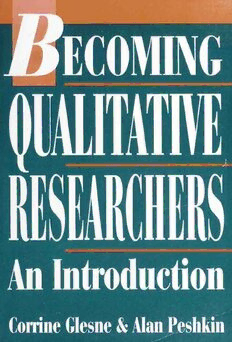
Becoming Qualitative Researchers: An Introduction PDF
Preview Becoming Qualitative Researchers: An Introduction
Digitized by the Internet Archive in 2017 with funding from China-America Digital Academic Library (CADAL) https://archive.org/detaiis/becomingqualitatOOgles An Introduction Corrine Glesne & Alan Peslikin University of Vermont University of Illinois at Urhana-Champaign mmm Longman BECOMING QUALITATIVE RESEARCHERS Copyright ® 1992 by Longman All rights reserved. No part of this publication may be reproduced, stored in a retrieval system, or transmitted in any form or by any means, electronic, mechanical, photocopying, recording, or otherwise, without the prior permission of the publisher. Longman, 10 Bank Street, White Plains, N.Y. 10606 Associated companies; Longman Group Ltd., London Longman Cheshire Pty., Melbourne Longman Paul Pty., Auckland Copp Clark Pitman, Toronto Senior editor: Naomi Silverman Development editor: Virginia Blanford Production editor: Linda Moser Cover design: Joseph DePinho Production supervisor; Richard Bretan Library of Congress Cataloging-in-Piiblicatioii Data Glesne, Corrine. Becoming Qualitative Re.searchers: An Introduction / Corrine Glesne and Alan Peshkin. p. cm. Includes bibliographical references and index. ISBN 0-8013-0295-1 1. Social sciences—Methodologv. 1. Peshkin, Alan. 11. Title. H6LG555 1991 300M —dc20 91 -22604 CIP 10 11 12 13 14-MA- 00 99 98 97 96 Contents Tables ix Acknowledgments Introduction: A Sense of Things to Come xiii Chapter 1 Meeting Qualitative Inquiry 1 Beginnings 1 Ways of Knowing 4 Qualitative/Quantitative Compatibility 8 The Variability of Qualitative Inquiry 9 What Is to Come 12 Chapter 2 Prestudy Tasks: Doing What Is Good for You 13 The Research Topic 14 The Problem Statement 16 Review of the Literature 17 Use of Theory 19 Site Selection 21 Selection of Research Techniques 24 Selection of Study Participants 24 The Time Frame 27 The Pilot Study 30 The Cover Story 31 Gaining Access 33 Researcher Roles 35 V VI CONTENTS Chapter 3 Being There: Developing Understanding Through Participant Observation 39 The Participant-Observation Continuum 40 Participant-Observation Goals 41 The Participant-Observation Process 42 The Participant Observer 54 Chapter 4 Making Words Fly 63 Developing Questions 65 Setting Up to Interview 73 The Nature of Interviewing 75 Interviewer Attributes That May Contribute to Successful Interviews 78 Some Typical Problems 87 Concluding Considerations and Summary 91 Chapter 5 The Personal Dimension: Rapport and Subjectivity 93 Rapport 93 Subjectivity 1(X) Rapport and Subjectivity 106 Notes 107 Chapter 6 But Is It Ethical? Learning to Do Right 109 Ethical Codes 110 Informed Consent 11 1 Researcher Roles and Ethical Dilemmas 112 The Researcher-Other Relationship 117 No Easy Solutions 124 Chapter 7 Finding Your Story: Data Analysis 127 Early Data Analysis 127 Data Display 137 Using Computers in Qualitative Research 141 Making Connections 145 Trustworthiness of Our Interpretations 146 Conclusions 148 Chapter 8 Writing Your Story: What Your Data Say 151 Roles of the Writer 152 Strategies for Writing 155 The Text: Questions of Form and Style 162 Responsibilities of the Writer 171 Chapter 9 The Continuing Odyssey 173 Applications of Qualitative Research: The Outcomes of Your Adventures 175 Concluding Words 179 References 181 Index 193 Tables Table 1.1: Predispositions of Quantitative and Qualitative Modes of Inquiry 7 Table 7.1: Subcodes of the Major Code “Data Analysis” 134 Table 7.2: A Matrix Example of Constraints to Effective Education in Six Rural Schools 138 Table 7.3: A Matrix Example of Data Patterns and Researcher Hunches Regarding Constraints to Effective Education in Six Rural Schools 139 Table 7.4: Partial Taxonomy of the Domain “Things Kids Do at School” 139 Table 7.5: Frequency Distribution of Perceived Attitudes toward Working the Land 140 Table 7.6: Frequency Distribution of Perceived Attitudes toward Working the Land by Dominant Land Tenure Situation of Interviewee 141 Table 7.7: Example Form for Keeping Interview Records 144 Table 8.1: Example of Theme Categories and Illustrative Responses 165 VII I i ( 1 i I I
